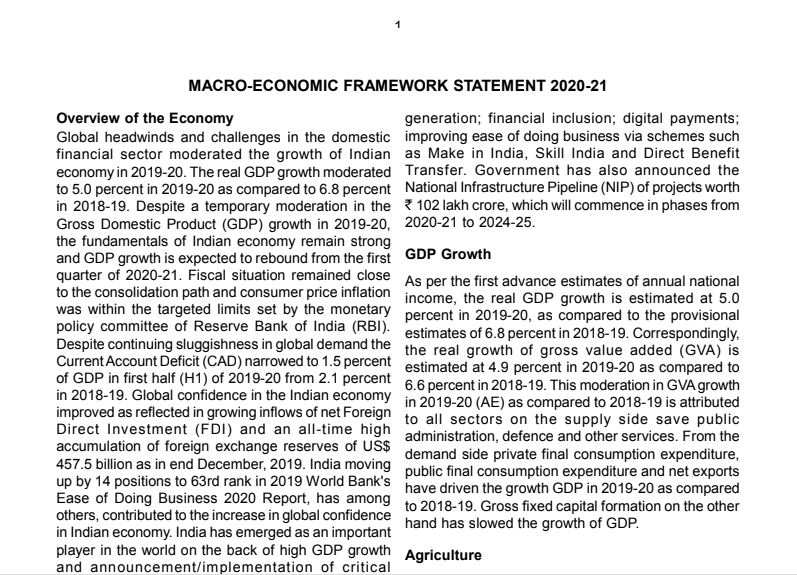MACRO-ECONOMIC FRAMEWORK STATEMENT 2020-21
MACRO-ECONOMIC FRAMEWORK STATEMENT 2020-21
Overview of the Economy
Global headwinds and challenges in the domestic financial sector moderated the growth of the Indian economy in 2019-20. The real GDP growth moderated to 5.0 percent in 2019-20 as compared to 6.8 percent in 2018-19. Despite a temporary moderation in the Gross Domestic Product (GDP) growth in 2019-20, the fundamentals of the Indian economy remain strong and GDP growth is expected to rebound from the first quarter of 2020-21. The fiscal situation remained close to the consolidation path and consumer price inflation was within the targeted limits set by the monetary policy committee of Reserve Bank of India (RBI). Despite continuing sluggishness in global demand, the Current Account Deficit (CAD) narrowed to 1.5 percent of GDP in the first half (H1) of 2019-20 from 2.1 percent in 2018-19. Global confidence in the Indian economy improved as reflected in growing inflows of net Foreign Direct Investment (FDI) and an all-time high accumulation of foreign exchange reserves of US$ 457.5 billion as in end December 2019. India moving up by 14 positions to 63rd rank in 2019 World Bank’s Ease of Doing Business 2020 Report, has among others, contributed to the increase in global confidence in the Indian economy. India has emerged as an important player in the world on the back of high GDP growth and announcement/implementation of critical measures in the current year and last few years.
The measures announced/implemented in 2019-20 include- hike in minimum support price of agricultural crops for 2019-20; reduction in corporate tax rate; policy initiatives for development of textiles & handicrafts and electric vehicles; an outreach programme for growth, expansion, and facilitation of micro, small and medium enterprises; incentives for start-ups in India; scheme to provide a one-time partial credit guarantee to public sector banks(PSBs) for purchase of pooled assets of financially sound non-banking financial companies (NBFCs); recapitalization of public sector banks, relaxation of external commercial borrowing guidelines for affordable housing; realty fund worth ` 25,000 crore for stalled housing projects; additional tax deduction of interest for affordable housing; merger of 10 public sector banks into four entities; revised Priority Sector Lending (PSL) norms for exports; and streamlining of many labour laws at the central government level. Apart from this, various steps were taken to boost manufacturing; employment generation; financial inclusion; digital payments; improving ease of doing business via schemes such as Make in India, Skill India, and Direct Benefit Transfer. The government has also announced the National Infrastructure Pipeline (NIP) of projects worth ` 102 lakh crore, which will commence in phases from 2020-21 to 2024-25.
GDP Growth
As per the first advance estimates of annual national income, the real GDP growth is estimated at 5.0 percent in 2019-20, as compared to the provisional estimates of 6.8 per cent in 2018-19. Correspondingly, the real growth of gross value added (GVA) is estimated at 4.9 per cent in 2019-20 as compared to 6.6 percent in 2018-19. This moderation in GVA growth in 2019-20 (AE) as compared to 2018-19 is attributed to all sectors on the supply side that save public administration, defense, and other services. From the demand side private final consumption expenditure, public final consumption expenditure and net exports have driven the growth GDP in 2019-20 as compared to 2018-19. Gross fixed capital formation, on the other hand, has slowed the growth of GDP.
Agriculture
In 2018-19, as per fourth advance estimates, food grain production in the country was estimated at 285 million tonnes, the same as in 2017-18. However, food grain production was 19.2 million tonnes higher than the average production of the previous five years. Rice production during 2018-19 was estimated at 116.4 million tonnes as compared to 112.8 million tonnes in 2017-18. Wheat production during 2018-19 was estimated at 102.2 million tonnes as compared to 99.9 million tonnes during 2017-18. The government has increased Minimum Support Prices (MSP) for all mandated Kharif, rabi and other commercial crops. The enhanced MSP ensures a return of 1.5 times overall India weighted average cost of production for the season 2019-20.
India continues to be the largest producer of milk in the world. The milk production in the country was 187.7 million tonnes in 2018-19 growing 6.5 percent over the previous year. The egg production in the country also increased from 95217 million in 2017-18 to 103318 million in 2018-19. Fish production in India has registered an average annual growth rate of more than 7 percent in recent years. Total fish production in the country stood at 13.4 million metric tonnes during 2018-19. Of this, the marine fisheries contributed 3.7 million metric tonnes and the inland fisheries 9.7 million metric tonnes. Under agriculture credit, a sum of ` 9,07,843.4 crore has been disbursed in 2019-20 as on 30th November 2019.
Prices
Consumer Price Index (Combined) (CPI-C) inflation for 2018-19 declined to 3.4 percent from 3.6 percent in 2017-18 and 4.5 percent in 2016-17. It averaged 4.1 percent in 2019-20 (April to December) and stood at 7.3 percent in December 2019. Food inflation based on the Consumer Food Price Index (CFPI) for 2018-19 declined to 0.1 percent from 1.8 percent in 2017-18 and 4.2 percent in 2016-17. It averaged 5.3 percent in 2019-20 (April to December) and stood at 14.1 percent in December 2019.
Inflation measured in terms of Wholesale Price Index (WPI) stood at 4.3 percent in 2018-19 as compared to 3.0 percent in 2017-18 and 1.7 percent in 2016-17. It averaged 1.5 percent in 2019-20 (April to December) and stood at 2.6 percent in December 2019.
Government has taken various measures from time to time to stabilize prices of essential food items through, inter-alia, trade and fiscal policy instruments like import duty, minimum export price, export restrictions, the imposition of stock limits besides advising States for effective action against hoarders & black marketers to regulate domestic availability and moderate prices. For increasing productivity and production in key segments of agriculture towards moderating prices, the government has been incentivizing farmers by announcing minimum support prices and implementing schemes such as Mission for Integrated Development of Horticulture (MIDH) and, National Mission on Oilseeds and Oil Palm (NMOOP), among others. The government is also implementing the Price Stabilization Fund (PSF) to help moderate the volatility in prices of agri-horticultural commodities like pulses, onion, and potato.
Industry
The Index of Industrial Production (IIP) grew at 0.6 percent during April-November 2019 as compared to 3.8 percent in 2018-19. Mining, manufacturing and electricity sectors in IIP grew at (-)0.1 percent, 0.9 percent, and 0.8 percent respectively during April- November 2019. The full-year growth in these three sectors in 2018-19 was 2.9 percent, 3.9 percent, and 5.2 percent respectively. Under the use-based categories growth in April-November of 2019-20 stood for primary goods at 0.1 percent, capital goods at (-) 11.6 percent, intermediate goods at 12.2 percent and infrastructure/construction goods at (-) 2.7 percent. The corresponding full-year growth of these categories in 2018-19 was 3.5 percent, 2.7 percent, 0.9 percent, and 7.3 percent respectively.
The eight-core infrastructure supportive industries, viz. coal, crude oil, natural gas, refinery products, fertilizers, steel, cement, and electricity that have a total weight of nearly 40 percent in the Index of Industrial Production (IIP) remained stagnant during April-November 2019 as compared to a growth of 4.4 percent in 2018-19. The production of fertilizers, steel, and electricity increased by 4.0 percent, 5.2 percent, 0.7 percent respectively during April-November 2019 while the production of coal, crude oil, natural gas, refinery products, and cement contracted by 5.3 percent, 5.9 percent, 3.1 percent, 1.1 percent, and 0.02 percent respectively during the same period.
External Sector
Merchandise exports (customs basis) during 2019- 20 (April-December), were US$ 239.3 billion, which declined by 2.0 percent over the level of US$ 244.1 billion in the corresponding period of the previous year. During 2019-20 (April-December), merchandise imports were US$ 357.4 billion, registering a decline of 8.9 percent over the level of US$ 392.3 billion in the corresponding period of the previous year. Oil imports declined from US$ 108.5 billion in 2018-19 (April-December) to US$ 95.7 billion in 2019-20 (April- December). Merchandise trade deficit improved from US$ 148.2 billion in 2018-19 (April-December) to US$ 118.1 billion in 2019-20 (April-December).
Following a rise in vulnerabilities in 2018-19, India’s external sector has regained some stability in the first half of 2019-20, with improvement in Balance of Payments (BoP) position anchored in narrowing of current account deficit from 2.1 in 2018-19 to 1.5 in H1 of 2019-20, growing inflows of foreign direct investment (FDI), rebounding of portfolio flows from net outflow to net inflow and receipt of robust remittances, all showing up in higher accretion of foreign exchange reserves, which as on end December 2019 stood at US$ 457.5 billion.
Net FDI inflows have continued to be buoyant in 2019- 20 (April-November) attracting US$ 24.4 billion as against US$ 21.2 billion, which is a reflection of a global sentiment that increasingly believes in India’s growth story and reform measures being undertaken by the government.
The average monthly exchange rate of rupee (RBI’s reference rate) was Rs. 70.41 per US dollar in 2019- 20 (April-December), as compared to Rs. 69.92 per US dollar during 2018-19. External debt as at the end of September 2019 remains low at 20.1 percent of GDP. After witnessing a significant decline since 2014-15, India’s external liabilities (debt and equity) to GDP have increased at the end of June 2019 primarily driven by the increase in FDI, portfolio flows and external commercial borrowings (ECBs).
Monetary Management and Financial Intermediation
Monetary policy remained accommodative during 2019-20. Five meetings of the Monetary Policy Committee (MPC) have been held so far in the financial year 2019-20. In the first four meetings, the MPC decided to cut the policy repo rate. The repo rate was reduced by 110 basis points (bps) from 6.25 percent in April 2019 to 5.15 percent in October 2019. In its fifth bi-monthly monetary policy statement in December 2019, the MPC decided to keep the repo rate unchanged at 5.15 percent.
The growth of reserve money as on December 27, 2019, was 10.2 percent over 17.0 percent on December 27, 2018. The expansion in reserve money was led by Currency in Circulation (CIC). Broad money (M3) growth has been on a declining trend since 2009. However, since 2018-19 growth of M3 has picked up and was marginally, mainly driven by the growth in aggregate deposits. The growth of M3 was 10.4 percent as of December 20, 2019, over 10.2 on December 20, 2018. The expansion in M3 so far during the year is attributable to aggregate deposits, which recorded a growth of 10.1 percent as of December 20, 2019, over 9.2 percent on December 20, 2018.
Banking and Non-Banking Sector
During 2019-20, gross non-performing advances(GNPA) ratio of Scheduled Commercial Banks (SCBs) remained unchanged at 9.3 percent in September 2019 as compared to March 2019. Similarly, the restructured standard advances (RSA) ratio of SCBs remained unchanged at 0.4 percent during the same period. The stressed advances (SA) ratio of SCBs followed suit by remaining flat at 9.7 percent. GNPA ratio of public sector banks (PSBs) was also unchanged at 12.3 percent in September 2019 while stressed advance ratios increased from 12.7 percent in March to 12.9 percent in September 2019.
The growth of non-food credit was 7.2 percent on November 22, 2019, as compared to 13.8 percent on November 23, 2018. The moderation in credit growth was witnessed across all the major segments of non- food credit except personal loans, which grew at 16.4 percent as of November 22, 2019, as compared to 17.2 percent as of November 23, 2018.
Non-Banking Financial Sector
After growing rapidly in 2017-18 and the first half of 2018-19, the NBFC sector has decelerated sharply since then. The growth of loans from NBFCs declined to 3.4 percent at the end of September 2019 from 14.6 percent in December 2018 and 31.9 percent in September 2018. The balance sheet of the NBFC sector grew by 17.9 percent from ` 26,17,790 crore to ` 30,85,480 crore during 2018-19. There is an observable shift in the sources of funding of NBFCs. Borrowings from banks increased from ` 5.62 lakh crore in October 2018 to ` 7.13 lakh crore in October 2019 registering a growth of 26.8 percent. However, deployment of credit by Mutual funds to NBFCs has been contracting since October 2018.
Capital Market
The primary market resource mobilization through 85 public and rights issues was ` 73,896 crore during 2019-20 (up to December 31, 2019) as against 124 issues which had raised ` 44,355 crores during 2018-19 (up to December 31, 2018). Funds raised through the private placement of 1,520 issues amounted to ` 6.29 lakh crores in 2019-20 (up to December 31, 2019) as compared to ` 5.3 lakh crores through 2006 issues in 2018-19.
India’s benchmark indices, namely, Nifty 50 and S&P BSE Sensex index, have continued to grow during 2019-20. The S&P BSE Sensex, the benchmark index of Bombay Stock Exchange (BSE), reached an all-time high closing of 41,681 on December 20, 2019, witnessing an increase of 7.2 percent from the level of 38,871 on April 1, 2019. Nifty50 index gained 5.3 percent over April 1, 2019, to close at 12,226 on January 3, 2020. The average annual growth of BSE and Nifty50 in 2019-20 (April-December) was 8.9 percent and 5.7 percent respectively.
Central Government Finances
The fiscal deficit and revenue deficit for 2019-20 were budgeted at 3.3 percent of GDP and 2.3 percent of GDP respectively. The BE 2019-20 envisaged a tax to GDP ratio of 11.7 percent and total expenditure to GDP ratio of 13.2 percent. The envisaged growth for gross tax revenue was 9.5 percent over 2018-19 Revised Estimates (RE). The total expenditure in BE 2019-20 was estimated to increase by 13.4 percent over 2018-19 RE.
As per the data on Union Government Finances released by Controller General of Accounts for April- November 2019, the gross tax revenue increased by 0.8 percent over the corresponding period of the previous year achieving 47.7 percent of the budget estimate. The non-tax revenue increased by 67.8 percent during (April- November 2019) over the corresponding period of the previous year achieving 74.3 percent of the budget estimate. At the end of November 2019, the non-debt capital receipts stood at 24.2 percent of the budget estimate.
Major subsidies (food, nutrient-based fertilizers, urea, and petroleum) increased by 7.3 percent during April- November 2019, as compared to April-November 2018. Urea subsidy increased by 52.7 percent and petroleum subsidy increased by 27.7 percent during April-November 2019, as compared to the corresponding period in 2018-19.
During April-November 2019, fiscal deficit reached 114.8 percent of the budgeted amount in 2019-20. During the corresponding period of the previous year, the same ratio had prevailed in relation to the 2018-19 budgeted amount. The revenue deficit for April- November 2019 is 128.4 percent of BE and is lower than the corresponding figure of 132.6 percent in the previous year. The Revised Estimates place fiscal and revenue deficits at 3.8 percent of GDP and 2.4 percent of GDP respectively in 2019-20.
Prospects
The growth of the economy appears to have bottomed out and is expected to pick up in 2020-21. The prospects for the Indian economy for the year 2020-21 need to be assessed in the light of emerging global and domestic challenges and opportunities. Major challenges for the economy arising from the external front are geopolitical tensions in the Middle East and rising crude oil prices due to supply disruption which may decelerate the growth and increase inflation. Challenges in the domestic front are the revival of investments and savings. The positive prospects for the economy are a continuation of structural reforms that will revive growth and expected normalization of credit flow as investment picks up induced by a cut in the corporate tax rate and anticipated transmission of repo rate cuts earlier implemented by the Monetary Policy Committee. Global economic growth is expected to pick up in 2020 which could also support India’s growth. In view of a positive outlook on the economic rebound, the nominal growth of the economy is expected to be 10 percent in the financial year 2020-21.
Download the copy:
If you already have a premium membership, Sign In.
 ConsultEase Administrator
ConsultEase Administrator
Consultant
Faridabad, India
As a Consultease Administrator, I'm responsible for the smooth administration of our portal. Reach out to me in case you need help.













